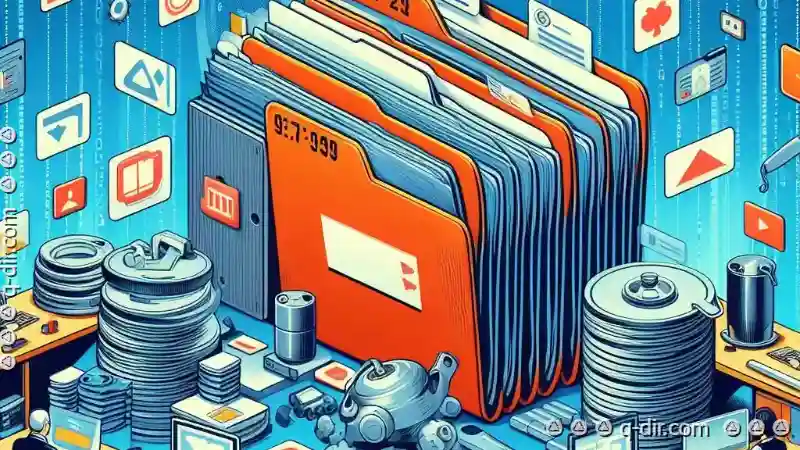Whether you're a professional or an amateur user, chances are you've encountered situations where you need to delete files from your computer but save the ...
 folders they were contained in. This article will guide you through the process of deleting files while preserving folder timestamps and discuss some common challenges that might arise during this operation. In today's digital age, managing files efficiently is crucial for maintaining productivity.
folders they were contained in. This article will guide you through the process of deleting files while preserving folder timestamps and discuss some common challenges that might arise during this operation. In today's digital age, managing files efficiently is crucial for maintaining productivity.1. Understanding the Basics
2. Methods for Preserving Folder Timestamps During Deletion
3. Unix-based Systems (Linux, macOS)
4. Windows (Using PowerShell)
5. Challenges in Preserving Folder Timestamps
6. Conclusion
1.) Understanding the Basics
Before diving into specific methods, it's essential to understand what we mean by "preserving folder timestamps." Typically, when a file is deleted from within a folder, the folder’s last modified timestamp does not change unless explicitly changed manually or through software. However, if you delete files using standard operating system functions (like Shift + Delete in Windows), these timestamps are often reset to the current time. This behavior can be particularly problematic when you want to maintain an accurate record of when a folder was last updated with content.
2.) Methods for Preserving Folder Timestamps During Deletion
1. Using Command Line Tools
3.) Unix-based Systems (Linux, macOS)
For users on Unix-based systems, the command line offers powerful tools to manipulate files and directories. One such tool is `find`, which can be used to delete files without altering folder timestamps if configured correctly.
find /path/to/folder -type f -deleteThis command will locate all files (`-type f`) within the specified path and delete them. By using this method, you ensure that only files are deleted, leaving the directory structure intact and preserving timestamps.
4.) Windows (Using PowerShell)
For Windows users, PowerShell is a versatile tool to achieve similar results:
Get-ChildItem -Path "C:\"path""to""folder" -File | Remove-Item -ForceThis script will recursively find all files within the specified folder and delete them without changing the directory timestamps.
2. Using File Management Software
There are several third-party software tools designed to handle file management tasks, including deleting specific types of files while preserving other components. Some popular options include:
- Recuva: A powerful data recovery tool that can selectively delete files without affecting folder structures or timestamps.
- CCleaner: Although primarily known for system cleaning, CCleaner offers advanced features to manage and clean your storage efficiently.
3. Manual Renaming of Files
A manual yet effective method is to rename the files rather than deleting them. This way, only the file names are removed without affecting the folder’s timestamp:
mv /path/to/folder/* /path/to/trash/This command moves all contents of the directory to a trash or backup location without actually deleting them, preserving the folder's last modified time.
5.) Challenges in Preserving Folder Timestamps
1. Metadata Management
While file timestamps are preserved, metadata related to files (like permissions, extended attributes) might not be retained perfectly across different filesystems and operations. This can lead to inconsistencies that need manual adjustment for compliance with organizational standards or legal requirements.
2. System Overhead
In some cases, especially when dealing with large numbers of files or very large files, the system overhead involved in preserving timestamps through deletion processes might slow down your system’s performance temporarily due to increased activity at the file level.
3. Software Limitations
Not all software tools designed for file management are equipped to handle this specific task perfectly. Some may fail to preserve timestamps reliably or might introduce new issues during operations, making it crucial to choose reliable and well-reviewed tools.
6.) Conclusion
Deleting files while preserving folder timestamps is a nuanced task that requires understanding the intricacies of file systems and metadata handling. While command line tools and specialized software can automate this process efficiently, manual methods using renaming or trash redirection are also viable options depending on your needs and technical expertise.
In conclusion, mastering these techniques not only enhances organizational efficiency but also deepens one's understanding of how digital data is handled under the hood. Whether you opt for automated solutions or manual overrides, choosing the right method depends entirely on your specific scenario and comfort level with technology.

The Autor: / 0 2025-05-22
Read also!
Page-

Single-Pane: The Digital Treadmill of Repetitive Tasks
This is particularly true for those who work with single-pane interfaces-a common design feature across various software platforms and devices. In ...read more

Is Microsoft Afraid to Radically Redesign File Filters?
One aspect that often sparks conversation among users and tech enthusiasts is the state of file filters in Microsoft applications. This blog post ...read more

Preview vs. Thumbnail View: Which is Faster?
When it comes to viewing content in applications such as image galleries or file managers, users often have to choose between two common views: ...read more